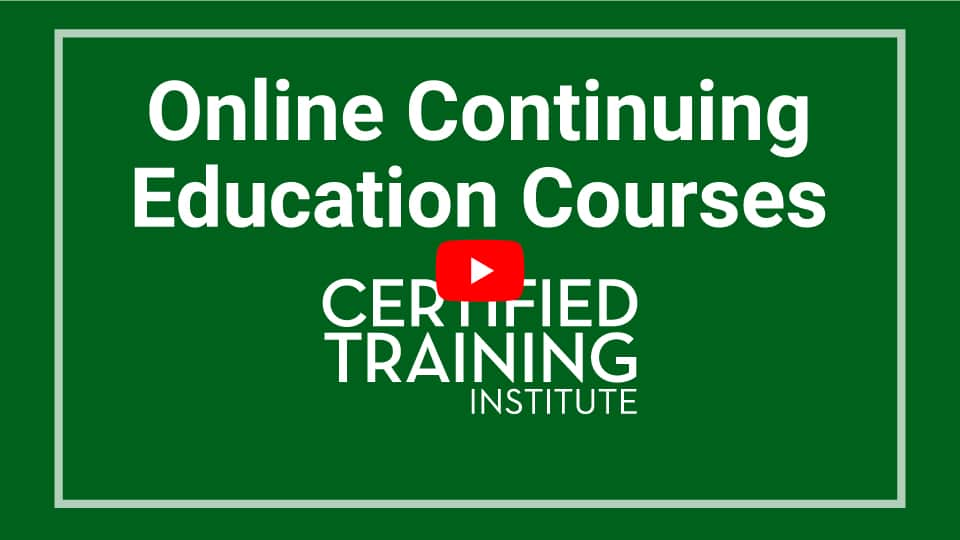Pesticide Applicator Continuing Education
Each course includes an official certificate of completion that you can save for your records. Looking for state reporting information? Learn more here.
Applicators must renew their certification each year by May 31st. Applicators have the option to renew for a two-year period. CE requirements must be met before renewing.
Certified applicators must complete 6 Credits each year.
Qualifying applicators must complete 12 Credits each year.
CE must be completed by 11:59 ET on 5/31 or you must retest.
Credits do NOT need to be category specific.
PMD Landscape Bundle
This 6-credit course bundle is designed for Arizona Applicators as licensed by the Pest Management Division. The course bundle contains 6 credits of training approved the the Arizona Department of Agriculture for PMD credit. Course topics focus on common ornamental and turf pest management issues. Please click on course details for a list of specific courses.
» View Package Content » Course Details
PMD Mosquito Management Bundle
» View Package Content » Course Details
PMD Ornamental Bundle
» View Package Content » Course Details
PMD Safety Bundle
This 6-credit course bundle is designed for Arizona Applicators as licensed by the Pest Management Division. The course bundle contains 6 credits of training approved the the Arizona Department of Agriculture for PMD credit. Course topics focus on common landscape management issues. Please click on course details for a list of specific courses.
» View Package Content » Course Details
PMD Structural Bundle
» View Package Content » Course Details
PMD Turf Management Bundle
» View Package Content » Course Details
PMD Wood Destroying Bundle
» View Package Content » Course Details
Application Equipment and Calibration
When pesticide applications become necessary for good turf management, it's important to understand how the application equipment works and how to properly calibrate the equipment. This course will provide turf managers with an understanding of the most common types of equipment used for pesticide applications on turf and how to properly calibrate the equipment.
Aquatic Weed Control
Managing aquatic weeds revolves around proper plant identification. Tailoring management strategies to address specific aquatic plant life is only possible through accurate identification. This course teaches the basics of aquatic weed identification and the different approaches to aquatic plant management.
Bed Bugs: Overview and Management
Structural applicators know that managing a bed bug infestation is difficult on many levels. This course looks at the history of bed bugs, current integrated pest management approaches to preventing and managing an infestation, and several of the chemical options available when your non-chemical controls and methods have failed.
Common Ornamental Plant Pests
Pest management of ornamental plants involves multiple steps from growing a healthy plant that is more resistant to pest damage to correctly identifying the problem when present. This course will cover the most common pests of ornamental plants.
Common Pests of Residential, Industrial & Institutional Structures
This course teaches Arizona pest managers how to control interior and exterior pests that can damage various types of property, infect people, and affect one's quality of life.
Common Turfgrass Weeds
Managing weeds in a turf stand can be a tricky proposition. Often times the client fails to recognize that the presence of weeds in a turf stand is the result of poor turf, not the cause. This course will provide applicators with a working knowledge of weed biology, weed identification, and how herbicides work.
Cultural Practices for Turf Management
Turf responds best to consistent cultural practices including mowing, irrigating, and fertilizing. But as turf managers know, there is a right way and a wrong way to do these. This course covers the dos and don'ts of good cultural practices that will result in a healthy vigorous turf that will be enjoyed for years.
Effective Pesticide Applications in Interiorscape Settings
Structural pesticide applicators in Arizona who take this course will understand indoor plant pesticide management. Topics covered throughout the course include how to properly select and apply pesticides, adhering to safety measures, and implementing Integrated Pest Management strategies.
General Pesticide Use Safety
This course covers Respiratory Protection, Personal Protective Equipment & Emergency Response, Pesticide Application Procedures, Pesticide Formulations, Pesticide Hazards & First Aid, Pesticides in the Environment, Planning the Pesticide Application, and Transportation, Storage, Security, & Professional Conduct.
Intro to Mosquito Control
To effectively manage a mosquito population as part of an integrated pest management plan applicators must be familiar with mosquito physiology, the lifecycle of the mosquito, and various collection and surveillance methods for both adult mosquitoes and larvae. This course will talk about surveillance methods, mosquito anatomy, and touch on the diseases that are most commonly vectored by mosquitoes in the United States.
IPM for Ornamental Plant Pest Management
IPM of ornamental plants involves multiple steps; producing a healthy plant, correctly identifying the problem, recognizing that there will always be some pests and damage, and only using pesticides as a last resort. This course teaches the basics of pest and disease management for ornamental plants, and the different tools and techniques needed to successfully provide your clients with a healthy and attractive landscape.
IPM for Termite Prevention
Termites are one of the most destructive pests in the United States. But there are several common-sense IPM practices that can be implemented to make a structure less inviting to termites from the start. This course will provide a review of IPM principles, termite biology, and several IPM practices to make any structure less attractive to termites.
IPM for Turf Management
As a turf manager, you'll need to be more than someone who just applies pesticides. Good turf management requires the use of all the tools in the toolbox. This course will touch on the best practice cultural, mechanical, biological, and chemical controls for turf management.
IPM Practices for Landscape Pest Management
This course teaches pesticide applicators in Arizona how to develop a structural integrated pest management (IPM) program. The course focuses on a variety of pest-management methods, such as augmentation, mechanical and cultural control, sanitation, and pesticide use.
Mosquito Identification
Correct identification of each mosquito species is an important step to managing the mosquito population in your area. Each species of mosquito has its own preferred habitat and breeding environment. This course covers the preferred habitat, breeding ground, and physiological differences between five major species of mosquitoes found throughout the United States.
Mosquito Management & Control
Mosquito management is a daunting task for many applicators. When mosquito management is done incorrectly or isn't done at all, mosquitoes can make public spaces unusable. This course will discuss common methods of mosquito controls, everything from physical controls to pesticides, to record-keeping, all as part of a solid integrated pest management approach to mosquito control.
Ornamental Pesticide Application Equipment and Calibration
When pesticide applications become necessary for good ornamental plant management it's important to understand how application equipment works and how to properly calibrate the equipment. This course will discuss the most common types of equipment used for pesticide applications on ornamental plants, the way to calculate the volume of solution needed, and how to properly calculate the flow rate of the equipment.
Personal Protective Equipment and Emergency Response
Wearing PPE can reduce exposure (dermal, inhalation, ocular, or oral) and thereby lower the chances of pesticide injury, illness, or poisoning. It is important that all pesticide applicators and handlers understand the protections and limitations of PPE.
Pest Control Practices in Residential, Industrial & Institutional Structures
This course teaches safe, effective, and economical pest control methods to prevent property damage, harm to people, and impact on quality of life. Structural pest managers will also learn how to make decisions that prioritize safety for themselves, others, and the environment.
Pest Identification of Common Landscape, Turf, and Interiorscape Pests
This course is designed to help Arizona pest control professionals identify a broad spectrum of invertebrate and vertebrate pests found in landscape and interiorscape environments. After completing this course, participants will understand how to address various pest-related problems and develop strategies for damage prevention.
Pesticide Application Procedures
Pesticides may be applied as sprays, dusts, granules, gases (vapors), fogs, baits, rubs, or dips and require the correct equipment for the pesticide as well as the job size and type. In addition, you must properly select, operate, calibrate, and maintain your equipment.
Pesticide Emergency Management and Environmental Protection
This course examines ways Arizona pest managers can protect both the environment and humans from pesticide hazards through safe and legal pesticide use. The course emphasizes elements of safe pesticide application and handling, including pesticide alternatives and management plans. Learn best practices for public and environmental safety like posting public warning signs and notifying the public.
Pesticide Hazards and First Aid
Pesticides are designed to be toxic so they can control pests (e.g., plants, insects, rodents, fungi, and bacteria) while not harming non-target organisms and anyone else exposed to the product. Pesticide users need to be concerned with the hazards associated with exposure to the chemical and not just the toxicity of the pesticide.
Pesticides in the Environment
Applicators and the public share concerns about how pesticides may harm the environment. Initially, hazards to humans were the primary reason the U.S. Environmental Protection Agency (EPA) decided to classify a pesticide as a restricted-use product.
Pollinator Stewardship
This course provides an outline of the primary concerns of the bee-keeping industry including colony collapse disorder (CCD), factors affecting honey bee decline, invasive insects, fungal disease, best practices for pollinator stewardship, and minimizing pesticide risks for pollinators.
Review of Pesticide Use Hazards
This course teaches Arizona pest managers about the classifications and hazards of pesticides. You will learn how to categorize various pesticides and how to recognize the toxicity danger they present to humans, pets, wildlife, and the environment.
Right-of-Way: Weed Control
This course will review the methods and techniques to manage vegetation on right-of-ways and non-cropland industrial sites safely without damage to non-target species, sites, objects, or the environment.
Structure Infesting Pest Management
Having a clear understanding of the hierarchy of insect classification is important. It helps us better understand the background of our pest decide the best course of action in controlling the pest. This course will cover some of the structure infesting pests commonly encountered by structural pesticide applicators and technicians.
Structure Invading Pest Management
As a pest control technician, it's important to be familiar with the pests in the region as well as where they reproduce. In some cases, it is difficult to determine if the designated living space is inside or outside. This course covers the identification and management of pests that generally live outside but will invade a structure if the conditions are favorable.
Turfgrass Disease, Insect, and Vertebrate Pests
There are a variety of diseases, disorders, insects, and vertebrate pests that can cause problems in turfgrass. This course will give applicators and turf managers an overview of these common pests and strategies for their management.
Wood-Destroying Pest Management
Termites are just one of the many wood-destroying pests found throughout the United States. Carpenter ants, powderpost beetles, and wood-damaging fungi can also cause severe structural damage if not properly managed. This course will cover the primary wood-destroying pests found through the country, the recommended treatments for each of those pests, and the primary sources of excess structural moisture.
Zika and Other Mosquito-Borne Diseases
This course covers a range of mosquito-borne diseases with an emphasis on the Zika virus. Zika's extent, side effects, testing, and diagnostics are detailed along with protection and reduction techniques of mosquitoes to minimize the transmission of mosquito-borne diseases.

